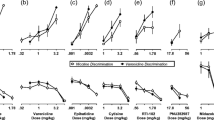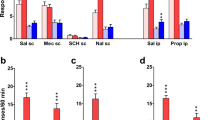Abstract
This study investigated the stimulus property of nicotine in the rat. The primary objectives of the study were 1. to determine the time course of the nicotine stimulus and its relationship to brain levels of the drug and 2. to determine whether the nicotine stimulus is dependent upon the integrity of specific neurotransmitter systems. A lever choice discrimination was used. After injection of nicotine, depression of one lever in an operant test chamber resulted in food reinforcement according to a variable interval schedule of 15 sec. When saline was administered, the opposite lever was reinforced. A high degree of discriminated responding was observed when either 400 Μg/kg or 200 Μg/kg of nicotine was used as a discriminative stimulus. The degree of discrimination decreased as the length of the time period between the injection of nicotine and the test of discrimination was increased. This decline in discrimination was similar to the decline in brain levels of nicotine suggesting that nicotine discrimination is directly related to the concentration of nicotine in the brain. Atropine, mecamylamine, dibenamine, propranolol and α-methyl-para-tyrosine (AMPT) were all tested, in a range of doses, for effects upon nicotine discrimination. Of these, only mecamylamine antagonized the nicotine stimulus. These results indicate that the stimulus effect of nicotine is mediated specifically through nicotinic-cholinergic receptors and not muscarinic-cholinergic or adrenergic receptors.
Similar content being viewed by others
References
Barry, H., III: Prolonged measurements of discrimination between alcohol and nondrug states. J. comp. physiol. Psychol. 65, 249–352 (1968)
Deneau, G. A., Inoki, R.: Nicotine self-administration in monkeys. Ann. N.Y. Acad. Sci. 42, 277–279 (1967)
Domino, E. F.: Electroencephalographic and behavioral arousal effects of small doses of nicotine in a neuropsychopharmacological study. Ann. N.Y. Acad. Sci. 42, 216–244 (1967)
Goodman, L. S., Gilman, A.: The pharmacological basis of therapeutics. New York: Macmillan 1970
Hirschhorn, I. D.: A study of hallucinogens as discriminative stimuli. Unpublished Ph.D. dissertation, S.U.N.Y. at Buffalo, 1971
Hirschhorn, I. D., Winter, J. C.: Mescaline and lysergic acid diethylamide (LSD) as discriminative stimuli. Psychopharmacologia (Berl.) 22, 64–71 (1971 a)
Hirschhorn, I. D., Winter, J. C.: Hallucinogens as discriminative stimuli: mescaline and LSD. Fed. Proc. 30, 504 (1971 b)
Hucker, H. B., Gillette, J. R., Brodie, B. B.: Enzymatic pathway for the formation of cotinine, a major metabolite of nicotine in rabbit liver. J. Pharmacol. exp. Ther. 147, 376–379 (1960)
Kubena, R. K., Barry, H., III: Generalization by rats of alcohol and atropine stimulus characteristics to other drugs. Psychopharmacologia (Berl.) 15, 196–206 (1969)
Lucchesi, B. R., Schuster, C. R., Emley, G. S.: The role of nicotine as a determinant of cigarette smoking frequency in man with observations of certain cardiovascular effects associated with the tobacco alkaloid. Clin. Pharmacol. Ther. 8, 789–796 (1967)
Morrison, C. F., Stephenson, J. A.: Nicotine injections as the conditioned stimulus in discrimination learning. Psychopharmacologia (Berl.) 15, 351–360 (1969)
Overton, D. A.: Dissociated learning in drugs states (state dependent learning). In: Psychopharmacology, a review of progress, 1957–1967, D. H. Efron, ed., pp. 918–930. Washington: U.S. Govt. Printing Office 1968
Overton, D. A.: Discriminative control of behavior by drug states. In: Stimulus properties of drugs. T. Thompson and R. Rickens, eds., pp. 87–110. New York: Appleton-Century-Crofts 1971
Rech, R. H., Borys, H. K., Moore, K. E.: Alterations in behavior and brain catecholamine levels in rats treated with α-methyltyrosine. J. Pharmacol. exp. Ther. 153, 412–419 (1966)
Schechter, M. D., Rosecrans, J. A.: C.N.S. effect of nicotine as the discriminative stimulus for the rat in a T-maze. Life Sci. 10, 821–832 (1971)
Schechter, M. D., Rosecrans, J. A.: Nicotine as a discriminative stimulus in rats depleted of norepinephrine or 5-hydroxytryptamine. Psychopharmacologia (Berl.) 24, 417–429 (1972)
Stolerman, I. P., Goldfarb, T., Fink, R., Jarvik, M. E.: Influencing cigarette smoking with nicotine antagonist. Psychopharmacologia (Berl.) 28, 247–259 (1973)
Weiss, G. B.: Dependence of (14C) nicotine distribution and movements upon pH in frog sartorius muscle. J. Pharmacol. exp. Ther. 160, 135–147 (1968)
Winter, J. C.: A comparison of the stimulus properties of mescaline and 2,3,4-trimethoxy phenylethylamine. J. Pharmacol. exp. Ther. 185, 101–107 (1973)
Author information
Authors and Affiliations
Additional information
A preliminary report of this investigation appeared in the Pharmacologist 15, 452 (1973).
Rights and permissions
About this article
Cite this article
Hirschhorn, I.D., Rosecrans, J.A. Studies on the time course and the effect of cholinergic and adrenergic receptor blockers on the stimulus effect of nicotine. Psychopharmacologia 40, 109–120 (1974). https://doi.org/10.1007/BF00421360
Received:
Revised:
Issue Date:
DOI: https://doi.org/10.1007/BF00421360




